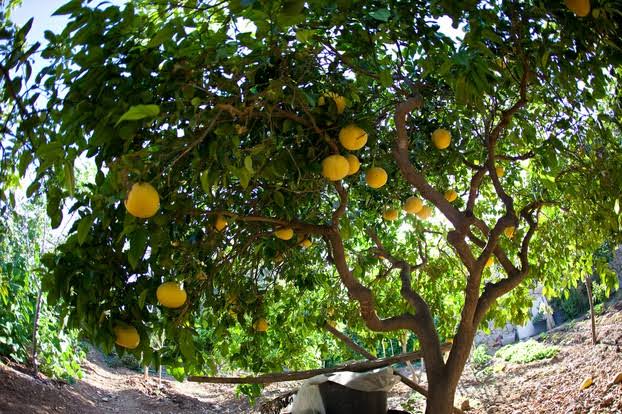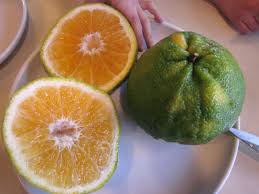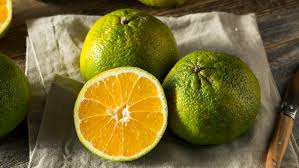The Ugli fruit, scientifically known as Citrus reticulata × paradisi, is a unique and delightful tropical citrus hybrid. This extraordinary fruit is a cross between a grapefruit, an orange, and a tangerine, resulting in a flavorful combination that appeals to many taste buds.
With its bumpy, greenish-yellow exterior, the Ugli fruit might not win any beauty contests, but don’t let its appearance fool you. Beneath the unassuming skin lies a juicy and tangy flesh that is a true treat for those who venture to taste it. The name “Ugli” perfectly captures the fruit’s unconventional appearance, making it stand out in the world of citrus fruits.
When you slice open an Ugli fruit, you’ll be greeted by a burst of citrusy aroma. The flesh is succulent, with a perfect balance of sweetness and tartness. Its vibrant orange color adds to the overall appeal, making it a visually enticing addition to any fruit bowl.
What sets the Ugli fruit apart is not just its taste but also its versatility. Whether enjoyed fresh on its own, added to fruit salads, or used in various culinary creations, the Ugli fruit lends a distinctive flavor that can elevate any dish. Its juice is also a popular choice, offering a refreshing and zesty alternative to traditional citrus options.
In addition to being a flavorful addition to the palate, the Ugli fruit also brings nutritional benefits. Packed with essential vitamins, particularly vitamin C, this citrus hybrid contributes to overall well-being. Its antioxidant properties make it a healthy choice, supporting the immune system and promoting skin health.
Hailing from Jamaica, the Ugli fruit has found its way into markets worldwide, captivating consumers with its unique taste and quirky appearance. It has become a symbol of tropical indulgence, offering a tropical escape in the form of a humble fruit.
From its bumpy exterior to its juicy and tangy flesh, this tropical gem has earned its place among the diverse array of citrus fruits, bringing joy and refreshment to those who have the pleasure of savoring its goodness.
Read Also: Methods of Castration in Sheep and Goat
The History of Ugli Fruit

The history of the Ugli fruit traces back to the island of Jamaica, where this unique citrus hybrid first emerged. The Ugli fruit is a result of natural hybridization, occurring spontaneously in the orchards of Jamaica. Its parentage involves the grapefruit (Citrus paradisi), the orange (Citrus sinensis), and the tangerine (Citrus reticulata).
The story goes that the Ugli fruit’s origins can be traced to a chance cross-pollination between these citrus varieties. Over time, local farmers noticed the emergence of a distinct fruit with a peculiar combination of characteristics. Despite its unconventional appearance, the fruit’s taste and juiciness garnered attention, leading to its cultivation and eventual recognition as a unique variety.
In the mid-20th century, the Ugli fruit gained prominence beyond Jamaica as its appeal reached international markets. Its introduction to global consumers was marked by its distinctive name, chosen to reflect the fruit’s less-than-perfect external appearance. The name “Ugli” not only captures the fruit’s physical features but also adds an element of humor and uniqueness to its identity.
As the Ugli fruit became commercially available, its popularity grew, and it found its way into grocery stores and kitchens around the world. Its ability to thrive in the tropical climate of Jamaica and its adaptability to different regions contributed to its widespread cultivation.
Today, the Ugli fruit holds a special place in the citrus family, celebrated for its refreshing flavor and versatility. Its history is a testament to the wonders of nature and the ability of humans to appreciate and cultivate unique and unexpected gifts from the plant kingdom. The journey of the Ugli fruit from a chance hybrid in Jamaican orchards to a global sensation is a fascinating chapter in the world of citrus cultivation.
The Nutritional Values of Ugli Fruits

The Ugli fruit, apart from its delightful taste, offers a range of nutritional benefits. Here’s a brief overview of the nutritional values found in this unique citrus hybrid:
1. Vitamin C: Ugli fruit is a rich source of vitamin C, a potent antioxidant that supports the immune system, promotes skin health, and aids in collagen production. A serving of Ugli fruit contributes significantly to the recommended daily intake of vitamin C.
2. Calories: Ugli fruit is relatively low in calories, making it a healthy snack option. Its natural sweetness provides a satisfying treat without excessive caloric intake, making it suitable for those mindful of their calorie consumption.
3. Fiber: This citrus hybrid contains dietary fiber, which is beneficial for digestive health. Fiber helps regulate bowel movements and can contribute to a feeling of fullness, supporting overall digestive well-being.
4. Potassium: Ugli fruit provides a moderate amount of potassium, an essential mineral that plays a role in maintaining proper heart and muscle function. Adequate potassium intake is associated with maintaining healthy blood pressure levels.
5. Hydration: The high water content in Ugli fruit contributes to hydration, supporting overall fluid balance in the body. Staying well-hydrated is crucial for various bodily functions and can positively impact skin health.
6. Natural Sugars: Ugli fruit contains natural sugars, including fructose and glucose, providing a natural energy boost. The combination of sweetness and tartness in the fruit enhances its appeal as a flavorful and energizing snack.
It’s important to note that while Ugli fruit offers these nutritional benefits, a well-rounded and diverse diet that includes a variety of fruits and vegetables is key to overall health. Incorporating Ugli fruit into your diet can be a tasty and nutritious way to enjoy the unique flavors and health-promoting properties this citrus hybrid has to offer.
Read Also: Ruminant Animals: A Comprehensive Guide
The Health Benefits of Ugli Fruit

The consumption of Ugli fruit comes with several health benefits, contributing to overall well-being. Here are some of the potential health advantages associated with including Ugli fruit in your diet:
1. Rich in Vitamin C: Ugli fruit is a potent source of vitamin C, a crucial antioxidant that helps boost the immune system. Adequate vitamin C intake is associated with reduced susceptibility to infections and enhanced immune response.
2. Antioxidant Properties: The presence of antioxidants in Ugli fruit, including vitamin C, helps combat oxidative stress in the body. Antioxidants play a role in neutralizing free radicals, which can contribute to cellular damage and aging.
3. Supports Skin Health: Vitamin C is essential for collagen synthesis, a protein that maintains skin elasticity and structure. Regular consumption of Ugli fruit can contribute to healthy skin by promoting collagen production and protecting against oxidative damage.
4. Aids Digestive Health: Ugli fruit contains dietary fiber, which promotes digestive health by supporting regular bowel movements and preventing constipation. Fiber also contributes to a feeling of fullness, aiding in weight management.
5. Hydration: With its high water content, Ugli fruit contributes to overall hydration. Proper hydration is vital for various bodily functions, including temperature regulation, nutrient transport, and waste elimination.
6. Heart Health: The moderate potassium content in Ugli fruit is beneficial for heart health. Potassium helps regulate blood pressure, reducing the risk of cardiovascular issues.
7. Natural Energy Boost: The natural sugars found in Ugli fruit, including fructose and glucose, provide a quick and natural energy boost. This makes Ugli fruit a nutritious and flavorful snack option.
It’s important to incorporate a variety of fruits and vegetables into your diet to ensure a diverse range of nutrients. While Ugli fruit offers these potential health benefits, individual nutritional needs may vary, and it’s advisable to maintain a balanced and varied diet for optimal health.
How to Grow Ugli Fruit (Growing Guide)
Growing Ugli fruit requires attention to specific conditions to ensure a successful harvest. Here’s a basic guide for cultivating Ugli fruit:
1. Climate: Ugli fruit thrives in tropical to subtropical climates. It prefers temperatures between 60-85°F (15-29°C) and cannot tolerate frost. If you’re in a region with cooler temperatures, consider growing Ugli fruit in a greenhouse to provide the necessary warmth.
2. Soil: The ideal soil for Ugli fruit is well-draining and slightly acidic to neutral. A pH range of 6.0 to 7.5 is suitable. Ensure good aeration and organic matter in the soil to support healthy root development.
3. Planting: Choose a sunny location with at least 6-8 hours of sunlight daily. Plant Ugli fruit trees in early spring or late fall when the weather is mild. Space the trees about 15 to 20 feet apart to allow sufficient room for growth.
4. Watering: Ugli fruit trees require regular watering, especially during dry periods. Keep the soil consistently moist but not waterlogged. Mulching around the base of the tree helps retain soil moisture.
5. Fertilization: Use a balanced fertilizer with equal parts of nitrogen, phosphorus, and potassium. Apply fertilizer in the spring before new growth begins and again in late summer. Follow recommended dosage guidelines to avoid over-fertilization.
6. Pruning: Prune Ugli fruit trees to shape them and remove dead or crowded branches. This helps improve air circulation and sunlight penetration, promoting fruit development. Pruning is typically done in late winter or early spring.
7. Pest and Disease Management: Keep an eye out for common citrus pests such as aphids, scale insects, and mites. Regularly inspect the foliage and treat any infestations promptly. Additionally, watch for signs of diseases like citrus canker or fungal infections, and take preventive measures.
8. Harvesting: Ugli fruit is typically ready for harvest in late winter to early spring. Harvest when the fruit reaches a vibrant color and is firm to the touch. Use pruning shears to cut the fruit from the tree, leaving a short stem attached.
Read Also: The Impact of Stress on Your Health and How to Manage It

